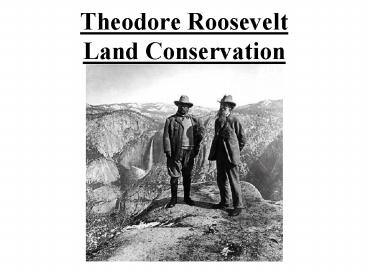Theodore Roosevelt Land Conservation - PowerPoint PPT Presentation
1 / 16
Title:
Theodore Roosevelt Land Conservation
Description:
Theodore Roosevelt Land Conservation Land Conservation The cornerstone to his Domestic Policy. Reasons for Conservation Government paid little attention to the nation ... – PowerPoint PPT presentation
Number of Views:239
Avg rating:3.0/5.0
Title: Theodore Roosevelt Land Conservation
1
Theodore RooseveltLand Conservation
2
Land Conservation
- The cornerstone to his Domestic Policy.
3
Reasons for Conservation
- Government paid little attention to the nations
natural resources in 1800s. - Private interests bought up the shrinking
wilderness. - Urban growth.
- Population increase.
- Immigration.
4
Industrialization
- Industrial waste dumped on land and in rivers.
- Mining stripped the land.
- Lumber companies over-logging affected flood
control.
5
(No Transcript)
6
Impact of Farming and Cattle Ranchers
- Pioneer farmers clearing forests and plowing the
prairies. - Overgrazing of cattle in the Great Plains.
7
Roosevelt Takes Action
- He alerted Americans that our resource supply was
not endless. - Roosevelt influenced by naturalists John Muir and
Gifford Pinchot.
8
His Accomplishments
- 150 National Forests.
- 51 Federal Bird Reservations.
- 4 National Game Reserves.
- 5 National Parks.
- 18 National Monuments.
- 24 Reclamation Projects.
- 7 Conservation Conferences and Commissions.
9
National Parks
Crater Lake, Oregon
10
Wind Cave, South Dakota
11
Sullys Hill, North Dakota
12
Platt, Oklahoma
13
Mesa Verde, Colorado.
14
- He fought unsuccessfully to make the Grand Canyon
a N.P. - He did protect it by declaring it a National
Monument. - It will become a N.P. in 1919 after Roosevelt was
president.
15
Antiquities Act 1906
- The first law to establish that archeological
sites on public lands are important public
resources. - Obligates federal agencies that manage the public
lands to preserve for present and future
generations the historic, scientific,
commemorative, and cultural values of the
archaeological and historic site and structures
on these lands.
16
continued
- Authorizes the President to protect landmarks,
structures, and objects of historic or scientific
interest by designating them as National
Monuments.






























